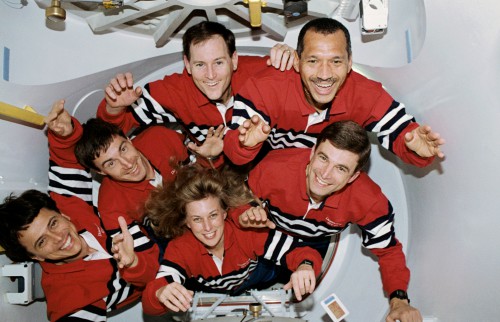
By the summer of 1992, the Soviet Union had collapsed. A coup the previous August—only three weeks after Bush and Gorbachev’s summit—by hard-like Communists had failed, and in December Gorbachev stepped down from power. In his place at the head of the new “Russian Federation” came President Boris Yeltsin, and in June 1992 his fragile nation and the United States issued a “Joint Statement on Co-operation in Space.” For the first time, it laid out the plans for cosmonauts to be flown aboard the shuttle, a docking mission between the shuttle and Mir, and at least one long-duration flight (of at least 90 days) by a U.S. astronaut. After several other meetings during the summer, in October NASA Administrator Dan Golden and his counterpart, Director-General of the new Russian Federal Space Agency Yuri Koptev, met in Moscow to sign the “Implementing Agreement on Human Space Flight Co-operation,” which explored the plan in further depth.
Late in October, Charlie Bolden’s STS-60 crew was named, with the addendum that “an experienced Russian cosmonaut” would join them on an eight-day flight, scheduled for November 1993. In making the announcement, former astronaut Steve Hawley, then serving as Acting Director of Flight Crew Operations, noted that the flight was “a significant milestone in future space exploration” and a critical “first step in our co-operative agreements with our Russian partners.” In addition to STS-60’s primary payload of the second Spacehab commercial research module and the unique free-flying Wake Shield Facility, it was announced that “Russian Space Agency-sponsored life science activities” would be carried out. Within days of the naming of Bolden, pilot Ken Reightler, and mission specialists Jan Davis, Ron Sega, and Franklin Chang-Díaz, the two cosmonauts appeared before journalists for a photo opportunity at the Johnson Space Center (JSC) in Houston, Texas.
Their training was difficult in more ways than one. In addition to an introduction to basic shuttle systems processes, the language and cultural problems remained a gulf to be bridged. “Even through an interpreter,” said one NASA manager, “it was a different language … [even] after we communicated!” As a case in point, Titov and Krikalev were taken on driving lessons, as it was feared they would be unable to cope with the aggressive Houston freeway traffic … until a handful of NASA trainers visited Russia a few months later. “After a few hours in Moscow,” one of them said, “I realised that we were totally silly for wasting our time trying to teach these guys how to drive in Texas. If they could survive Moscow traffic, then they had no problem whatsoever driving!” At length, early in April 1993, after “an intensive, three-month training programme,” Sergei Krikalev was named as the prime candidate. By this time, further plans for the new partnership had evolved.
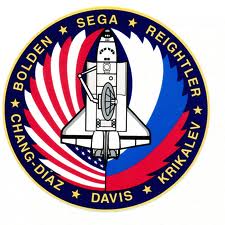
In late November 1992, NASA revealed that it was actively investigating the usefulness of Russia’s Soyuz-TM spacecraft as a possible emergency rescue vehicle for Space Station Freedom. Notably, this development emerged as U.S. and Russian officials met at JSC for two weeks of working group meetings … the first such meetings since the ASTP era. Then, in December 1993, only weeks before the STS-60 launch, Dan Goldin and Yuri Koptev agreed to stage a total of ten shuttle docking missions to Mir in 1995–97, with U.S. astronauts spending up to 21 months aboard the station, as “Phase 1” of a three-phase programme to bring the Russians into the now-renamed “International Space Station” effort. Under the terms of the agreement, Vladimir Titov would be assigned his own shuttle flight, STS-63, which would also attempt a close-range rendezvous—but not a docking—with Mir in the spring of 1995.
Although it was not mandatory for them to do so, the STS-60 crew requested a measure of Russian language tuition. “While we didn’t need it for flight,” said Bolden, “it would be really a nice gesture if we could at least communicate some simple things in Russian from on-orbit.” Fluency in such a short span of training time was impractical, but the ability to send greetings to Russian schoolchildren from space was a strong motivator. A newly-formed independent contractor, TechTrans International, Inc., found them a Russian language instructor, who met with the astronauts several times each week and taught them rudimentary terms and even a traditional children’s lullaby, called “Tired Toys are Asleep.” “We were told that every Russian child would recognise the song,” continued Bolden, “and if we did it right, we could sing it at 8 o’clock, Russian time, and they would be impressed.”
Less impressive were the apartments into which Titov and Krikalev were placed, situated in a complex on the corner of NASA Road 1 and El Camino. Bolden had asked his pilot, Ken Reightler, to take the cosmonauts under his wing, and within a few days he first became aware of problems. “Charlie, we’ve got to get them out of those apartments,” said Reightler. There was nothing wrong with them, but Reightler felt that Titov and Krikalev would get a better feel for American life if their families were settled into individual family homes. “We took them around and put them with a realtor,” said Bolden, “and let them pick the place where they wanted to live.” NASA managers agreed, the costs were covered, and the Krikalevs ended up in Middlebrook, a suburb of Clear Lake, whilst the Titovs settled in Friendswood. Bolden tried to organise happy hours, church activities, and other social functions to bring the cosmonauts and their families into the fold.
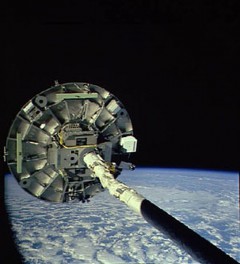
All but one member of the STS-60 crew had prior flight experience. Sergei Krikalev had participated in two long-duration missions aboard Mir, whilst Bolden and Chang-Díaz had both flown three times, and Reightler and Davis once apiece. Sega was making his first flight, but had worked extensively on the development of the Wake Shield Facility (WSF). Before becoming an astronaut, Sega was a research associate professor of physics at the University of Houston, affiliated with Director of the Space Vacuum Epitaxy Center (SVEC) Alex Ingatiev. Today known as the Texas Center for Superconductivity at The University of Houston (TcSUH), this institution has for more than two decades explored thin-film deposition, processing, and characterisation of semiconducting, high-temperature superconducting, and ferroelectric oxide material systems. As long ago as the 1970s, NASA engineers published papers arguing that a satellite sailing through space would leave an “ultra-vacuum” in its wake, but the absence of practical applications at the time meant that the idea was left unexplored until Ignatiev and his team revived it.
In 1986, they joined forces with nine other companies to form a Center for the Commercial Development of Space—one of several industry-academia partnerships, sponsored by NASA’s Office of Advanced Concepts and Technology—with the plan to build the Wake Shield Facility (WSF). It was conceived as a 12-foot-wide stainless steel disk, to be deployed from the shuttle’s Remote Manipulator System (RMS) mechanical arm for the purposes of generating an “ultra-vacuum” within which to grow thin films for future advanced electronics applications. Its purely functional shape made it appear like a factory cast-off: of dull, silver-grey colour, it was a clumsy arrangement of boxes, rods, tubing, and angular shapes. The WSF was designed, built, and managed by the SVEC, along with its industrial partner, Space Industries, Inc., of League City, Texas.
In March 1989, SVEC and Space Industries, Inc., formally partnered with NASA and carried the payload from the drawing board to the launch pad in less than 60 months and around $12 million. From the outset, it was presented as a major “first,” since the generation and characterisation of an ultra-vacuum in space had never been attempted. The inclusion of Ron Sega as a member of the STS-60 crew was invaluable, and the complex unberthing, atomic “cleaning,” deployment, rendezvous, and capture operations were planned in the most optimum fashion to ensure the maximum possible scientific yield from the mission.
Primary objectives of WSF-1 (the first of up to four flights of the satellite) were to characterise the ultra-vacuum environment and employ the techniques of molecular and chemical beam epitaxy to grow a thin film of gallium arsenide (GaAs) on a prepared substrate. Upon this substrate, atomic or molecular beams of arsenic and gallium formed thin films in layers, to create a “wafer,” with an ultra-high-purity top region. The WSF was designed to grow epitaxial films on seven different substrate wafers, and it was expected that, on STS-60, the free-flyer would produce at least one “thick” GaAs film. The importance of this material in digital cellphones, high-speed transistors, high-definition television, and fibre-optic communications and optoelectronics was already known to hold “a very promising economic advantage.”
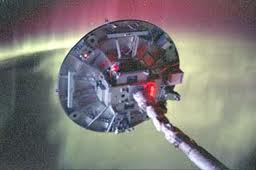
Gallium arsenide was thought to yield electronic devices eight times faster than silicon, whilst at the same time requiring a mere tenth of the power demand … but could not be easily produced on Earth of sufficiently high purity and quality. “If improved GaAs material were available,” noted NASA’s press kit for STS-60, “it could significantly impact the global semiconductor market,” whose worldwide consumption in 1990 alone reached $56.8 billion and whose projection for 1994 had risen to $109 billion. “Within this giant market,” continued the press kit, “GaAs currently holds only a 0.5 percent niche. It is predicted that the niche for GaAs should grow to 2 percent (or about $2.2 billion) by 1995.”
Although a moderate, “natural” vacuum was known to exist in low-Earth orbit, it was hoped that the forward-facing (or “ram”) side of the WSF would “push” even the few atoms present out of the way, leaving a unique ultra-vacuum in its wake and producing conditions between a thousand and ten thousand times better than was attainable in the best ground-based vacuum laboratories. Despite ostensibly representing the relatively “dirty” side of WSF, the ram could be used to support other experiments, including technology payloads. To make the most of this facility, four payload-attach points were placed on the ram side.
A fully-equipped spacecraft in its own right, the free-flyer had cold-gas propulsion thrusters to effect a satisfactory separation distance from the shuttle and silver-zinc batteries to provide 45 kilowatt-hours of power for the thin-film growth cells, heaters, process controllers, and other instruments. Mounted on the “wake” side of the spacecraft, in addition to the epitaxy process control equipment, were pressure gauges, mass spectrometers, potential analysers, and a video camera, together with the attitude-control system, the batteries, and solar panels. Meanwhile, attached to the ram face of the disk were the avionics hardware and associated support equipment.
Occupying roughly a quarter of Discovery’s payload bay on STS-60, WSF-1 was mounted atop a bridge-like truss structure and plans called for it to be grappled and unberthed by the RMS arm, under the control of astronaut Jan Davis, on the third day of the mission. Not surprisingly, Ron Sega served as lead crew member for the payload itself, and it is interesting that his then-wife, fellow astronaut Bonnie Dunbar, had also come into contact with the WSF in a professional capacity a few years earlier. In 1987–88, she was a member of the astronaut office’s Science Support Group and worked extensively on future shuttle payload proposals from industry and academia in the area of microgravity research … one of which came from Alex Ignatiev at SVEC for the Wake Shield.
The original November 1993 launch date for STS-60 quickly moved into the spring of the following year as NASA’s shuttle manifest writhed and contorted in the wake of two pad aborts and their impact on downstream flight. The mission got off to a fine start, with an on-time liftoff from the Kennedy Space Center’s Pad 39A at 7:10 a.m. EST—exactly the time published in the press kit, several weeks earlier—on 3 February 1994. Shortly after orbital insertion, Franklin Chang-Díaz, in his role as the payload commander, and Jan Davis oversaw the opening of the Spacehab-2 module and the activation of its experiments. During this period, a procedure of removing a diffuser cap from the middeck floor air duct fitting and placing it on the floor of the tunnel adaptor was scheduled to be performed. However, due to the lack of sufficient clearance between the adaptor floor fitting and the adaptor floor itself, normal positioning was not possible. As a result, the diffuser cap was grey-taped into position, and this posed no further difficulties.
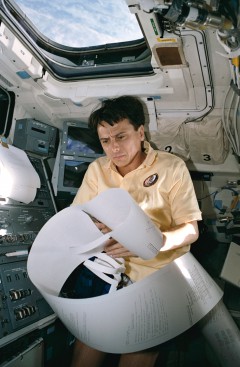
Like its predecessor, Spacehab-1, in the summer of 1993, this second mission exploited the enlarged volume of the commercial middeck augmentation module, which almost tripled the amount of experiment space for middeck-sized lockers. In terms of systems performance, Spacehab-1 met 100 percent of its pre-mission success criteria, and the NASA experiments achieved in excess of 90 percent of their requirements. The primary research focuses of Spacehab-2 were upon biotechnology (including the creation of improved pharmaceutical products and studying immune-system disorders) and microgravity research (including the sintering of metals and the production of important protein crystals). Twelve payloads within the module—and one atop its flat roof—supported a wide range of experiments, several of which were sponsored by a handful of NASA Centers for the Commercial Development of Space.
As a crew, the astronauts and Krikalev divided themselves equally among the experiments. Since this was the first opportunity for NASA’s Space and Life Sciences Directorate to work on a real manned mission with Moscow’s Institute of Biomedical Problems, an additional thrust of the research was space medicine. Krikalev and Davis worked on a number of neural sensory investigations, inner-ear balance studies, and the influence of the microgravity environment upon the eyes. Meanwhile, Bolden and Chang-Díaz were the guinea pigs for blood draws, urine samples, and specimens of saliva. During their training cycle, the two men—neither of whose backgrounds had anything to do with medicine, for Bolden was a Marine Corps aviator and Chang-Díaz a space plasma physicist—trained and were certified as “phlebotomists,” qualified and capable of taking venous blood draws. Every couple of weeks, throughout 1993, at the flight surgeon’s office they would be presented with a line of volunteers on whom to “practice.” “Franklin and I both hated it,” Bolden told the oral historian, “because we hated sticking people!”
With the activation of Spacehab-2 completed, the major activity of the third day of the mission, 5 February, was the grapple, unberthing, and deployment of the Wake Shield Facility. Plans called for the disk-shaped craft to spend about 48 hours in free-flight, after which it would be recaptured by the RMS and returned to its berth in the payload bay for the return home. Under Jan Davis’ expert control, the mechanical arm was checked out and WSF-1 was grappled at 6:13 a.m. EST and unberthed from its support structure an hour later. Davis firstly manoeuvred the payload into its so-called “ram-cleaning” position, which was essential for the atomic oxygen of low-Earth orbit to “scour” its ram side and atomically cleanse it in readiness for two days of semiconductor processing. It was during this three-hour process that the proper configuration of the payload was rendered uncertain, because its status lights were washed out by fierce sunlight. Attempts to troubleshoot the problem resulted in a loss of communications capability with the satellite, and the crew was directed to berth it back in the payload bay overnight and await a decision from Mission Control on their next steps.
By 3:48 p.m. EST, the free-flyer was back on its support structure. Over the next few hours, engineers evaluated the situation and determined that the communications problem “was related to near-field radio frequency (RF) multi-path interference on the WSF or a payload RF communication problem.” This problem was remembered clearly by Charlie Bolden, years later, for the Wake Shield Facility had cost a mere $12 million, as opposed to the hundreds of millions invested in most satellite projects. “One of the ways they saved money was limiting the amount of pre-flight testing,” he said. “One of the crucial tests that they did not do was an Electromagnetic Interference Test, whereby you put the satellite together in its flight configuration and turn it up and see if there is interference among different components.” WSF-1 was powered-up in the integration room at the Kennedy Space Center and appeared to function perfectly. “But when they bundled up all these feet of electrical cable,” continued Bolden, “you get a current generated. When we powered up the Wake Shield Facility on-orbit and tried to turn on the attitude-control system, there was a 5 Hz signal that was generated by the power cables … that shut down the attitude-control system and wouldn’t let it run! Every time we tried to power it up, it would start spinning and cut itself off.” The crew had no idea what was causing the problem, but they instinctively knew that they could not reliably deploy WSF-1 if they had no control over its motions.
It was reflective of NASA’s “faster, better, cheaper” policy, instituted by Administrator Dan Goldin. Bolden looked upon the matter with a measure of sadness. Although he admired the science and technology behind the Wake Shield, and dearly wanted it to succeed, Bolden was disappointed that expense had been spared in its final months of testing. It was, he said scornfully, “manufactured in a storefront.”
Early the following morning, Davis prepared for another bid to deploy the satellite. At 6:14 a.m. EST on 6 February, she gingerly unberthed and extended WSF-1 on the end of the arm. Again, there were communications dropouts, but these were resolved with a hard reboot of the satellite’s computer. However, all was still not well. During a standard check, data indicated that the satellite’s attitude could not be properly ascertained and efforts to troubleshoot the problem by aiming its horizon sensor toward the Sun to warm it up were fruitless. A second deployment opportunity later that day was missed because WSF-1 remained unready to go. Matters were hampered further by the fact that there was insufficient time to safely develop contingency procedures in the event that the satellite was unable to effect stable attitude control. At length, Mission Control told the disappointed astronauts that WSF-1 would not be deployed and that all GaAs operations would take place whilst firmly attached to the RMS.
In the days to come, the mission would be disparagingly nicknamed “The Wake Shield Fallacy” by some sections of the media, but even as it “hung” on the end of the RMS arm, the satellite demonstrated its capabilities. Five thin semiconducting films were successfully grown and the satellite was finally berthed in the payload bay at 7:18 a.m. on 9 February. Although the results were demonstrative of the practicality of the Wake Shield concept, it was a far cry from what should have happened, and it is important to consider the original flight plan for a fully-deployed WSF-1.
Had circumstances been different, after the ram-cleaning process, Davis would have put the satellite through an hour of vacuum measurements and released it over the starboard wall of Discovery’s payload bay. Flying freely, WSF-1 would have employed its cold-gas thrusters to manoeuvre itself “ahead” of the orbiter, thereby avoiding the risk of contamination from waste water dumps, fuel cell purges, and engine bursts. It was expected that the two vehicles would remain at a distance of about 45 miles for the next two days. With the shuttle’s pilots, Charlie Bolden and Ken Reightler, handling the orbiter, Franklin Chang-Díaz would have tracked the rate of separation distance with a laser range-finder, whilst Davis and Krikalev tended to the RMS arm and Ron Sega kept watch over the Wake Shield’s systems. At length, on 7 February, Bolden and Reightler would have manoeuvred Discovery from 45 miles to a “station-keeping” position of about nine miles, whereupon Krikalev would have powered-up the RMS for the retrieval. The pilots would then have performed a “Terminal Initiation” burn, with the scope for four smaller course-correction firings, before Bolden was due to take manual control for the final approach.
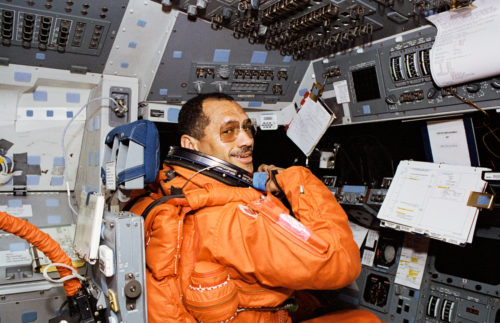
As the shuttle drew nearer to its quarry, a series of plume impingement tests were planned. Between the distances of 400 feet and 200 feet “ahead” of WSF-1, the pilots would have executed a four-hour series of thruster firings to characterise the behaviour of their exhaust and allow the satellite’s instruments to measure the composition, accelerations, and pressures. (Since the Wake Shield would have completed its ultra-vacuum work by this time, the impingement tests would not prove a contamination risk.) One of the key aims of this plume-impingement work was to assess the extent to which thruster firings could be executed in close proximity to other spacecraft, including Russia’s Mir orbital station. Finally, Bolden would have guided Discovery to within 10 m of WSF-1 to enable Krikalev to grapple the payload. It would then be “parked” above the payload bay, overnight, followed by final berthing. Although the Wake Shield would fly twice more after STS-60—and both missions would involve successful deployments and retrievals and encouraging results—it was with a measure of angst that the crew returned home to KSC’s Shuttle Landing Facility at 2:19 p.m. EST on 11 February, having been unable to run the new payload through its paces to completion.
For Bolden, it was a lost opportunity to fly a “rendezvous” mission in his astronaut career. None of his three previous flights had included rendezvous. He had sorely desired command of the first Hubble servicing flight, but had not gotten it. “I had not flown a rendezvous mission,” he told the NASA oral historian, “and I was really excited about being able to rendezvous with something, since I wasn’t going to be around for the International Space Station.” The list of astronauts waiting for their first flights was increasing and more were about to be selected, later in 1994, and Bolden had been approached to return to active duty in the Marine Corps as Deputy Commandant of Midshipmen at the Naval Academy. In August 1994, he retired from NASA and returned to the military. Of course, it was not to be the end of Bolden’s involvement with the space agency, and in July 2009 he was appointed as NASA Administrator.
This was illustrated in light-hearted fashion by Bolden at the mission’s post-flight press conference, when he offered the audience the tongue-in-cheek chance to ask questions about “what we thought we did … in case we did something that you didn’t think we did … or we didn’t do something that you thought we did.” Yet the first flight of the Wake Shield Facility had shown what it could do, and in September 1995 and November 1996 it would be reflown and its capabilities realised. A fourth flight, capable of producing up to 300 epitaxial thin-film wafers, was planned and its integration and test schedule was approved, but by the end of 1997 NASA funding ran out. Several months later, in May 1998, SVEC granted exclusive licence to Spacehab, Inc., to market, manage, and operate the WSF, and there were hopes that a five-year free-flyer might be launched. Ultimately, with the emphasis of the shuttle upon building the International Space Station—which, in 2003, was punctuated by the loss of Columbia—this did not come to pass and the satellite never flew again.
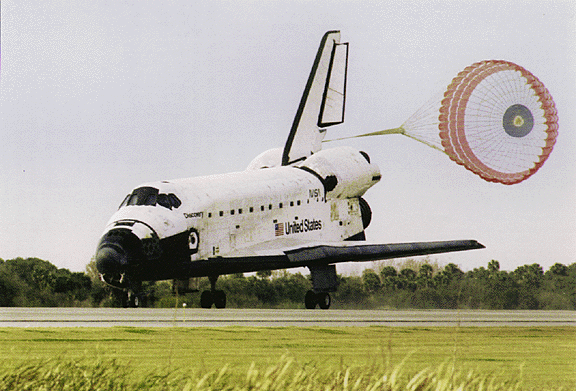
As for Spacehab-2, many of its experiments produced exceptionally pleasing results. Perhaps the most obvious “problem” was the partial collapse of the flexible rubber duct between Discovery’s environmental control and life-support system supply line to the Spacehab floor fitting. In his post-flight press conference, Bolden referred to it as the “collapsed rubber duck.” It was significantly “crimped” and Chang-Díaz and Davis were sufficiently concerned that it might restrict airflow into the module.
Bolden called the ground and advised them of the crimped duct. A little investigation identified the cause as a blockage in Spacehab’s atmospheric revitalisation system fan inlet debris screen in the fan inlet muffler. The blockage increased the suction in the environmental control and life-support system line and caused the duct to collapse. Whilst Mission Control mulled over the issue, Sergei Krikalev floated over to find out what was happening. As a cosmonaut with two long-duration Mir missions behind him, Krikalev had nine times more flight experience than the rest of the shuttle crew put together. He was perplexed at the Americans’ stance. His question was simple: “Why don’t we fix it?” As logical as the question seemed, it did not fit in with the normal shuttle protocols, which required support and consensus from the ground. “The stuff you guys do just doesn’t make any sense,” he said, paraphrased by Bolden in his oral history. “On Mir, I wouldn’t even have called them. I’d have fixed it and then I’d let them know what we had done.”
Several days later, Chang-Díaz happened to be running a televised guided tour of the orbiter, speaking in Spanish, for a Costa Rican audience. As he passed through the tunnel from Discovery’s middeck into the Spacehab module, he happened upon the crimped duct. He mentioned it in passing to his audience. Not long afterwards, Mission Control called Bolden in surprise: “You guys didn’t tell us it was that bad!” Proposals to fix the duct were quickly sent up to the crew, but the astronauts found them unsatisfactory. Then the orbiter passed out of direct communications with the ground and Krikalev suggested an impromptu repair to clean the screen and insert the stiff plastic cover of the on-board atlas to reinforce the collapsed duct. “If you … rolled it up and stuck it inside the hose,” explained Bolden, “then it expands. It wants to go back to being flat … and makes the hose stand out.” Upon seeing videotaped footage of the fix, Mission Control made no comment, but after the flight someone approached Bolden. “We wish you hadn’t just gone ahead and done it,” he said. “We wouldn’t have disagreed with it if you’d told us that’s what you were planning to do!” In the minds of both Bolden and Krikalev, it was a lesson in the different working practices of the Americans and the Russians.
It was a lesson that both sides would learn through bitter experience as they got down and dirty with the Shuttle-Mir programme in the next few years.
This is part of a series of history articles, which will appear each weekend, barring any major news stories. Next week’s article will focus on Friendship 7, the United States’ first orbital space mission by John Glenn, way back in February 1962.



